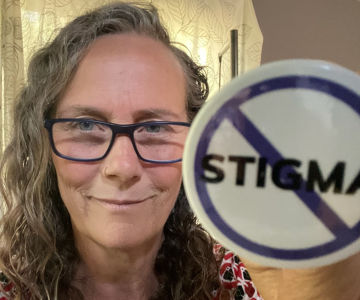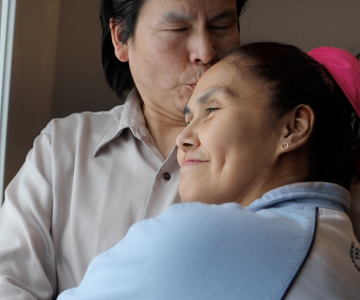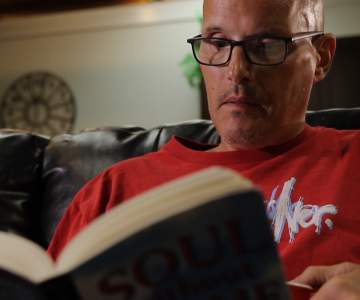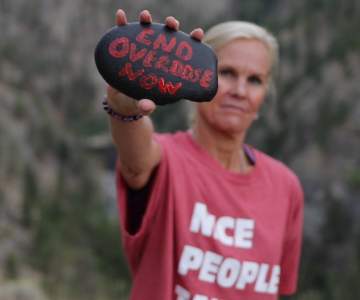Breadcrumb
Explore Stories
Health & Wellness
Guest post by Alison Houweling, harm reduction coordinator with Interior Health
With International Overdose Awareness Day (IOAD) here, I think about the concept of stigma. Stigma is a hot button topic and honestly, I think some people are tired of hearing the word. But it is one of the most significant barriers to people getting help.
Stigma often brings to mind the idea of judgment and negative views happening to a person. What is not explored is the internalized and perceived stigma that happens within a person. Understanding that aspect of stigma could be a gamechanger for how we connect with people who use substances. To better understand these internal experiences, I will share my own experience of stigma and substance use.
Community & Culture
To say that Rachel has a big heart would be an understatement. Despite experiencing a lifetime of loss, she smiles easily and is quick to laugh.
Rachel wants to help people in whatever way she can. That is why she agreed to share her story and speak about the impact of stigma as a person who uses drugs.
She greets us at the door with bubbly enthusiasm, her freshly washed hair pulled up in a towel. She doesn’t seem nervous about being interviewed. She and her husband Jason are excited to host us. In fact, we are the first guests to visit their new home. Refreshments are offered. The apartment is spotless.
A dream catcher with bright orange feathers hangs in the corner. Rachel’s husband made it, along with the wood carvings, sketches and paintings on display.
Pinned above the living room couch are three certificates confirming Rachel has completed “Peer Support Training” - the training necessary to work with community agencies as a person with lived experience helping others with substance use issues.
But when asked about her own family upbringing, her struggles with addiction, and her experience of stigma, those warm brown eyes immediately brim with tears.
“I felt crappy,” she recalls. “I wouldn’t feel that I was worthy – I wasn’t good enough for myself, or for my spouse. Not good enough to be a sister, a daughter, or a mother. It was hard.”
Rachel began using substances in her thirties, and cocaine use quickly grew to include crystal meth and heroin. Over the years Rachel lost jobs, family members, beloved friends and special belongings. Things like the dress passed down from her mother that was always intended for Rachel’s one-day wedding. It is difficult, if not impossible, to hold on to precious items in the midst of addiction and homelessness.
Still, she managed to hold on to what is most dear to her: her life with Jason. The two now share a small apartment in the Okanagan, keeping largely to themselves, focussing on their recovery and working on their art. Rachel loves colouring and Jason is an avid drawer, painter and carver. They also volunteer, participating in community clean-ups, peer support groups and other initiatives.
“All of us, we’re all equal,” Rachel says about the need to end the stigma around addiction and substance use. “We want just the same as you – to live life and be happy.”
Watch and share the video and learn about Rachel’s story. Check out more resources about stigma and substance use. Help #EndStigma.
Rachel's story is the final in a four part series of stories and videos about the stigma faced by those impacted by substance use.
Community & Culture
Brian is a familiar figure in his community. He is an avid reader who enjoys hiking and is sometimes seen walking with his pet Bearded Dragon draped over his shoulder.
“I love her. She keeps me out of trouble,” he says affectionately. “She was quite small when she was born - she was a runt. I wasn’t sure if she was a boy or a girl, so I named her Sasha.”
He is involved in multiple volunteer projects, such as community clean-ups and anti-stigma work, and provides harm reduction support at the local outreach centre.
“I volunteer doing outreach, giving out harm reduction supplies. I teach people how to use Naloxone. I work at the Cammy Lafluer clinic. I like to help out, steer someone away from using drugs if I can, but if not, I’ll teach them how to do it right, to be safer.”
Brian’s story began in a Vancouver hospital where he was born with serious health complications due to his biological mother’s heroin and alcohol use.
After spending the first year of his life in hospital, Brian was adopted. He grew up in Cranbrook, doing “normal kid stuff” like playing soccer, riding motorbikes, and fishing. But it was never easy.
“I was always awkward. I felt like I was in the way, like I didn’t fit in,” he recalls.
That feeling changed the first time he experienced an opioid. As a young teen he was given morphine in hospital following an injury. For the first time in his life, he says, Brian felt normal…like he belonged.
It is a sentiment supported by substantial research. "Literature shows a connection between trauma and opioid use. We know that early childhood trauma - like being in a hospital for a year - changes the brain and makes it vulnerable to the effects of opioids," says Interior Health Substance Use Director Corinne Dolman.
It was the beginning of a longstanding dependency on opioids, which Brian has managed with prescription methadone for more than 30 years.
“I’ve definitely been impacted by stigma. I see it every day.”
“Just accept people as they are. Just treat people the way you want to be treated.”
“It’s that simple.”
Watch the video and share Brian’s story. Check out more resources about stigma and substance use. Help #EndStigma.
Brian's story is part three in a four part series of stories and videos about the stigma faced by those impacted by substance use.
Community & Culture
Fifty-year-old Shane is an active volunteer, a former hockey player and a trivia buff.
Like many couples, he and his wife Joanne often tease each other.
“She doesn’t have a volume switch. I’ve been trying to find it for years,” he says of Joanne, who is so soft-spoken you need to lean in close to hear her.
“I didn’t come with a volume switch. Or a return policy,” Joanne quietly quips back.
Joanne and Shane moved to the Okanagan a few years ago, but it wasn’t easy. They spent time living outdoors when they were unable to find housing. Money ran out quickly.
Having experienced both substance use issues and homelessness, they know about shame and blame firsthand.
“Every homeless or drug addicted person I know has been impacted by stigma. If you carry a back-pack, you’re not allowed to use a washroom, even in a business where you eat every day,” Shane says.
”Stigma is everywhere. We need to get rid of it, for everyone. Not just for the homeless or addicted but as a race.” He pauses. “Whoa I’m getting deep now, holy cow.” He laughs to lighten the mood, but his words are true.
It was the impact of stigma that spurred Shane to begin advocating for marginalized people in their community. He is a co-founder of VEPAD – Vernon Entrenched People Against Discrimination – a support group of sorts, that is active in harm reduction efforts, community clean-ups, and education.
“Don’t paint everybody with the same brush and don’t be so quick to judge. It can happen to anyone. I’m proof of that,” Shane says. “I come from an upper middle class family. I was always a confident person until 10 years ago.”
“I’d never used drugs in my life. I didn’t drink much. All of a sudden one night I had a line of cocaine put in front of me, and I fell in love with it right then and there. I couldn’t get enough of it. I lost everything to it.”
The stigma surrounding homelessness and substance use weighs on you, Shane says, until you are looking down all the time and it feels like nobody cares about you.
When they were invited to share their lived experience at a business event, Shane realized how many people and agencies there are in town that do care.
“And now I guess we’re one of them,” he says, referring to VEPAD. “And I like that.”
Watch the video and learn about Shane's story. Check out more resources about stigma and substance use. Help #EndStigma.
Shane’s story is part two in a four part series of stories and videos about the stigma faced by those impacted by substance use.
Community & Culture
Jill is blond, fit and full of energy. She often wears her hair in a bouncy ponytail. But there is a sadness around Jill’s eyes that somehow conflicts with the spring in her step.
The Okanagan mother of two recently retired from a career as a renal nurse. She spends her days in the mountains, running and hiking. Her favorite place to go is the hills behind Penticton, where she can spend time in the quiet and lose herself in memories of time spent with her son Daniel, who also loved the outdoors. Sadly, Daniel fought demons even a mother’s love couldn’t help.
Daniel died in 2016 from a fentanyl overdose. It was a week before his 24th birthday. After years of battling addiction, he had been substance-free for 17 months. The family was getting ready to celebrate together. But he died alone in his car outside a Kelowna park. It was the car they had so much fun buying together – a G37 Infiniti that Daniel loved.
Looking back, Jill says she had underestimated the risk of relapse and the role of stigma. “He was too ashamed to come to us and tell us that he had relapsed, that he needed help,” she says.
Many people don’t realize that opioid use disorder is a chronic relapsing condition, and there can be tremendous stigma about relapse because it is felt to be a personal failure.
“I can't change what happened that day,” Jill says. “What I can do is use the pain of my loss to help me be more aware of the suffering of others, and try to be more open in sharing my emotions and vulnerabilities. I have learned so much from Daniel, both through his life and sadly his death. His death has transformed me. How could it not?”
“Living without one of your children is the most unnatural way for any mom to live out her years. I have learned how to connect more deeply and meaningfully with my family, friends and life… One of the many gifts that Daniel left for me.”
Watch the video and learn about Jill and Daniel’s story. Check out more resources about stigma and substance use. Help #EndStigma.
Jill's story is part one in a four part series of stories and videos about the stigma faced by those impacted by substance use.
-
Showing 5 of 5
Sign up for email updates
Receive news, alerts, public service announcements and articles right to your inbox.






